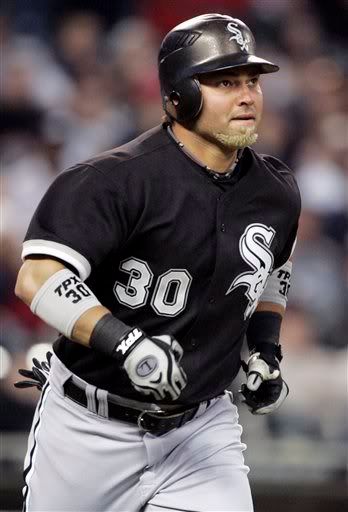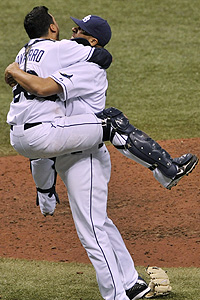
Today, the Mariners made what will be their most significant move of the off-season. With Jack Zduriencik (pronounced zur-EN-sik), the Mariners now have a permanent replacement for Bill Bavasi. After nearly five months under interim leadership, the organization officially has direction once again.
There are many reasons to be excited about Zduriencik. The first has little to do with him, but with the men who hired him. Howard Lincoln and Chuck Armstrong have been under fire in recent years, and justifiably so, especially after the 2008 collapse we just witnessed. Armstrong in particular has been the team president for many years, and by all accounts is a fantastic person to work under. However, I wondered if the game had passed by him. He hired Pat Gillick and Bill Bavasi under his watch, both GMs with significant previous experience running teams. On top of that, the managers and players the team pursued (with the exception of Bob Melvin) under those two GMs all tended to have significant experience. Rich Aurilia has experience. Scott Spiezio has been there before. Jeff Cirillo has a long track record of success. Jarrod Washburn has established himself as a major-league starter. Do these lines sound familiar?
Experience and track records are worth something, but not as much as this organization has valued it over the past five years. This became most apparent last off-season, when Carlos Silva was signed. The Mariners were stretching Brandon Morrow and Ryan Rowland-Smith out to be starters in winter ball, and both were having success. However, instead of trusting their own youth, they preferred the experience and proven track record of Carlos Silva, even though it came with a stiff price tag. Of course, it is easy to pick on the Silva signing after the poor season he had. But, the real point I am trying to make is that Ryan Rowland-Smith proved he can be a good starter, and Brandon Morrow flashed signs of dominance. Why didn't the organization see that last off-season?
Apparently, Chuck Armstrong and Howard Lincoln were asking similar questions. When I saw the list of the four finalists earlier this week, I could tell that they had done some soul-searching, and legitimately had changed what they were looking for. None of them had ever been a GM before. Only two of the four (Kim Ng and Tony LaCava) even had experience as an assistant GM. Experience did not matter with this search as it has in the past.
What struck me the most though was that all of the finalists, except for Ng, had extensive backgrounds in scouting and player development. While the Mariners have never frowned on player development, they hardly have pumped out a bunch of stars the past decade. Truthfully, Pat Gillick was horrible in this regard, and Bavasi had done some good. However, he still neglected position players fairly badly, and also got a major boost from international scouting, which Bob Engle has quite a bit more to do with anyway. The renewed (or perhaps fresh) emphasis on player development from Lincoln and Armstrong also helps to explain why the organization went on record and said, even before hiring a new GM, that they would not sign a big-money free agent.
Even before today's announcement, I was feeling good about the organization's direction. The overemphasis on experience appeared to be over with. The farm system appeared to be a bigger priority than ever. Both of these are very big steps forward. Look no further than both World Series teams, the Phillies and Rays. The core of each team was built through their farm systems. The Red Sox did not rise to prominence until they developed guys like Kevin Youkilis, Jonathan Papelbon, Jon Lester, Dustin Pedroia, Hanley Ramirez, and Anibal Sanchez (remember, Ramirez and Sanchez were key parts in the trade that netted Josh Beckett and Mike Lowell). Think back to the late '90s Yankees. Bernie Williams, Jorge Posada, Derek Jeter, Andy Pettitte, and Mariano Rivera were all products of their farm system. Tino Martinez, another important piece, was acquired by parting ways with Russ Davis and Sterling Hitchcock - both prospects they developed. An organization with a strong farm system will field a strong team, no matter their payroll. Moreover, when teams with farm systems have money to spend, their is the potential for a dynasty.
So, getting back to Zduriencik after a long tangent, one reason I like him is because he is a guy I do not think Lincoln and Armstrong would have considered very seriously even a year ago. His hiring is a tangible sign that this organization assessed where it was at, and has actually moved in a new direction.
Ultimately, what really gets me excited about Zduriencik though is his unparalleled track record when it comes to player development. Brewers GM Doug Melvin got a contract extension largely thanks to Zduriencik, who was Milwaukee's equivalent to Bob Fontaine. Look at the team the Brewers fielded this past year. Prince Fielder, Rickie Weeks, J.J. Hardy, Bill Hall, Ryan Braun, and Corey Hart are all players that Milwaukee developed in their farm system. Sure, Doug Melvin can be given some credit for shoring up the pitching staff with CC Sabathia, but who did he use to acquire the burly southpaw? That's right, prospects, namely blue-chip slugger Matt LaPorta. Of course, one reason the Brewers could make such a gutsy move is because they have other prospects like Mat Gamel, Alcides Escobar, and Cole Gillespie working their way through the system right now. There is a reason Zduriencik is the only non-GM ever to recieve the Baseball America Executive of the Year award.
It is not like all of these guys were sure-fire stars on draft day either. Many teams were concerned about Prince Fielder's weight, but not Milwaukee. Others thought they took LaPorta much too high, and nobody thought he would ever be a capable outfielder (except for Zduriencik and the Brewers, of course). In his time as a director of player development, he has shown creativity, vision, and confidence in himself, even when he goes against popular thinking. I do not know who Zduriencik plans to retain from the current Mariners staff, but I think that him at GM, Fontaine at scouting director, and Bob Engle staying VP of International Operations would make an incredible trio. Zduriencik particularly seems to have an eye for hitters, Fontaine an eye for pitchers, and Engle continues to more than supplement the system with young international talent. Just imagine a team that had drafted sluggers like Fielder and Braun, yet also drafted pitchers like Brandon Morrow and Chris Tillman, and then signed guys like Felix Hernandez and Carlos Triunfel.
Still, I have my concerns with Zduriencik. He has extremely limited experience in other important GM duties, namely trades and contract negotiations. He has to hire a manager. He has to evaluate aging players on this roster, not just up-and-coming youngsters. These are all things that he did not have to do much of (if any) in his role with the Brewers. I know that assistant GMs do get a taste for all those parts of the job, which is why I probably would have picked Tony LaCava. He comes from a strong player development background himself, and he also is an assistant GM right now. However, it is not as if Zduriencik has proven he cannot handle all the duties of GM. He has never had a chance to show what he can do it at all.
In the end, it is hard to argue that Zduriencik was not the right pick. I am excited to see what he does. I certainly am more excited about him than I ever was about Bill Bavasi. A youth movement is going to begin in earnest, and it should be real exciting once Zduriencik gets some draft picks to play with. I am certainly looking forward to the changes that he will make.
 Nobody spends money like the New York Yankees. Lots of people have said the Red Sox are the new Yankees, but not even they can compete off the field with their arch rivals. Sure, New York had tons of contracts come off their payroll, so they had nearly $100 million to spend. They had pitching holes too, so it was easy to see them throwing as much money at CC Sabathia as it took to sign him. It wasn't even that far-fetched to see them add A.J. Burnett. But now, adding Mark Teixeira for 8 years and $180 million...come on.
Nobody spends money like the New York Yankees. Lots of people have said the Red Sox are the new Yankees, but not even they can compete off the field with their arch rivals. Sure, New York had tons of contracts come off their payroll, so they had nearly $100 million to spend. They had pitching holes too, so it was easy to see them throwing as much money at CC Sabathia as it took to sign him. It wasn't even that far-fetched to see them add A.J. Burnett. But now, adding Mark Teixeira for 8 years and $180 million...come on.











